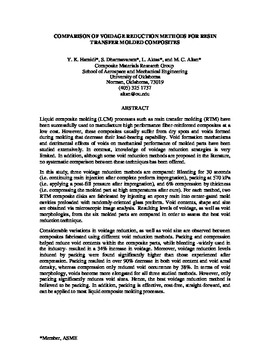| dc.description.abstract | Liquid composite molding (LCM) processes such as resin transfer molding (RTM) have been successfully used to manufacture high performance fiber-reinforced composites at a low cost. However, these composites usually suffer from dry spots and voids formed during molding that decrease their load-bearing capability. Void formation mechanisms and detrimental effects of voids on mechanical performance of molded parts have been studied extensively. In contrast, knowledge of voidage reduction strategies is very limited. In addition, although some void reduction methods are proposed in the literature, no systematic comparison between these techniques has been offered.
In this study, three voidage reduction methods are compared: Bleeding for 30 seconds (i.e. continuing resin injection after complete preform impregnation), packing at 570 kPa (i.e. applying a post-fill pressure after impregnation), and 6% compression by thickness (i.e. compressing the molded part at high temperatures after cure). For each method, two RTM composite disks are fabricated by injecting an epoxy resin into center-gated mold cavities preloaded with randomly-oriented glass preform. Void contents, shape and size are obtained via microscopic image analysis. Resulting levels of voidage, as well as void morphologies, from the six molded parts are compared in order to assess the best void reduction technique.
Considerable variations in voidage reduction, as well as void size are observed between composites fabricated using different void reduction methods. Packing and compression helped reduce void contents within the composite parts, while bleeding -widely used in the industry- resulted in a 34% increase in voidage. Moreover, voidage reduction levels induced by packing were found significantly higher than those experienced after compression. Packing resulted in over 90% decrease in both void content and void areal density, whereas compression only reduced void occurrence by 38%. In terms of void morphology, voids become more elongated for all three studied methods. However, only packing significantly reduces void sizes. Hence, the best voidage reduction method is believed to be packing. In addition, packing is effective, cost-free, straight-forward, and can be applied to most liquid composite molding processes. | en_US |
